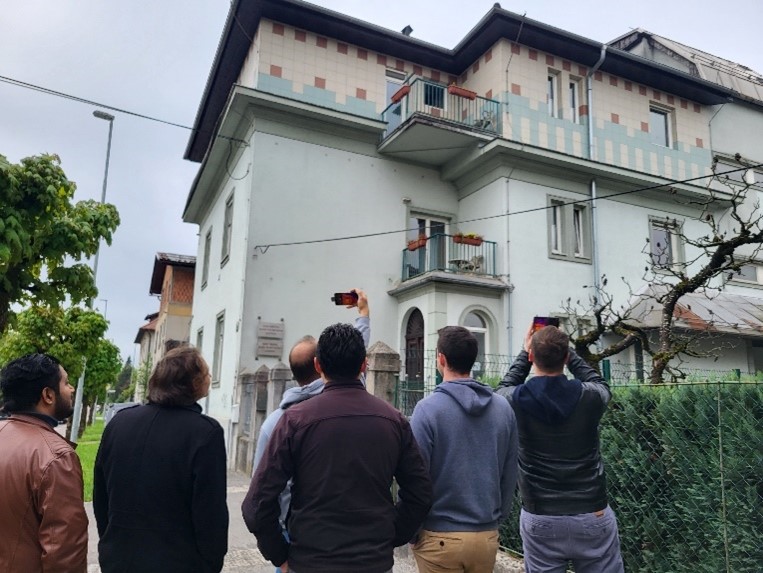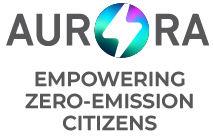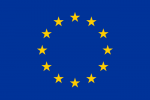The AURORA programme has been experimenting with thermal photography or thermography to highlight across our demonstration sites the wastage of energy in both private and public buildings. This article highlights what we found, what works well and will hopefully inspire other to adopt the same approach.
What is thermal photography?
Thermal photography, or thermography, is a technology that captures and creates an image of an object by using infrared radiation emitted from that object, visually displaying surface temperatures. Thermography can be used for a variety of purposes, from monitoring mechanical and electrical equipment, to detecting elevated skin temperatures in the medical sector and tracking animals in wildlife conservation.
This article showcases the variety of uses for thermography in detecting energy ‘leakages’ and engaging citizens in the topic of energy and energy wastage.
Aarhus University (AU)
AU ran two types of engagement using thermal photography:
- A contest with students to get them to submit thermal images that a) identified thermal leakages in buildings around the campus, b) detected faults in solar plant installations or c) identified ‘Hidden Energy Problems’. The winner was awarded a 500 kr (67 €) gift card to use in different shops around Aarhus, supporting small local businesses.
- A community event in the main library for families with children to learn about the technology. The participants were able to use cameras to spot potential thermal leakages from the library building and from objects. Photos that were taken were able to be submitted into a contest to win a gift card prize, and all participants got a ‘smiley’ sticker to show they participated.
These activities helped to identify potential thermal leakages in buildings on campus and at the main library. They also helped children understand basic concepts of heat and energy through fun activities, and supported engineering students to better understand thermal dynamics and reflect on energy consumption.
The cameras that were used for the activities were the RS PRO T-10 Thermal Imaging Camera for Android phones and the InfiRay P2 Pro for iOS phones.
AU intend to repeat these activities later in 2024 or early in 2025.

Universidad Politécnica de Madrid (UPM)
UPM ran a workshop with students on the fundamentals of thermal photography and how to use thermographic cameras. They allowed the students to keep the cameras for the week and submit an image into a contest to win a basket of ecological products as well as academic credits towards their qualification.
Students were encouraged to use the cameras to explore their surroundings from a new perspective and ask themselves how and why different temperatures observed could be linked to their energy management habits.
The camera model that was used is the UTi721M Smartphone Thermal Camera.
The workshop and contest were well received, with one student feeding back: “I really loved this workshop, the university should offer more activities like this.”
The prize winners will be announced on social media, hopefully generating interest from members of the community who did not participate. UPM intend to organise another contest in the next academic year, dedicating more time to explaining how the thermal images are used in research and industry.

University of Ljubljana (UL)
UL students hosted a guided tour of Ljubljana city centre using thermographic cameras to spot energy wasting buildings. The camera that was used is the InfiRay P2 Pro for Android phones.
Some highlights that were discovered during the guided tour include:
- The cameras helped students to see the levels of insulation across different buildings in the city.
- They found that there was a lot of energy wastage coming from older buildings built in the ‘energy boom’ period of the 1970s. They were also able to identify and compare these buildings with those that had been renovated to be more energy efficient.
- They discovered that renovation (including new thermal envelope) was more common in individual homes compared to public buildings.
- Among some of the most energy wasting buildings were important embassies, faculties and various national associations, showing that the importance of buildings is not necessarily linked to concern for energy efficiency.
The students who participated in the tour gained valuable experience. One student fed back: “It is now clear to me why the energy performance certificates that the state has mandated for all buildings by law are so important.”
The workshop led to new services being offered by the AURORA Ljubljana local energy community named ŠEK – Student Energy Club to all students of UL: WATTOTEKA (free rental of an electricity meter) and TERMOTEKA (free rental of a thermographic camera). In both services, the devices are borrowed on a one-week loan so the student can take the devices home and measure the energy efficiency of their homes.


Forest of Dean
The AURORA FOD team (Forest of Dean District Council and Centre for Sustainable Energy) have been supporting the energy community, Forest Community Energy (FCE), to run a pilot thermographic camera loaning service for local residents to detect heat loss in their homes.
Following a successful demonstration workshop at a local community centre, FCE volunteers were trained up on using thermographic cameras and giving energy advice and then ran the pilot scheme centred around the community centre. As well as the community centre itself, thermography was used by 10 local people on their own homes. Two ‘Energy Café’ events were also run at the community centre to promote the service and give advice to local residents on how to be more energy efficient.
The camera models that were used in this scheme were the Flir One Edge Pro and the Flir C3-X.
Some of the highlights that came out of the pilot include:
- The cameras were easy to use and helped residents to identify areas where insulation was present in buildings and where it was missing (in walls, around pipes, around loft hatches).
One resident fed back: “The talks and use of this equipment was very eye opening, highlighting the problem areas. I used the cameras over two nights, they were very easy to use”.
- The results of the images are being used to target draught proofing and insulation measures, as well as, in the case of the community centre, develop a ‘Building Energy Sustainability Plan’ and apply for grant funding to pay for double glazed windows.

- The Forest of Dean has a lot of inefficient older and traditional homes that are difficult and expensive to insulate, sometimes impossible given strict planning regulations in the UK. Residents need to be supported to find sources of advice and funding to help install measures in their homes.
Going forward, AURORA FOD and FCE would like to see this approach replicated through other community ‘hubs’ in the future. Community hubs could include community centres, village halls, libraries, shops…

To read a full overview of how the scheme was run and a reflection on the learnings, read the full article aqui.
Product comparison table
Accuracy of images | Useability (easy to use?) | Cost effective? | Anything else? | |
206 x 156 pixels |
Yes – plugs into smart phone using app. |
Yes |
Works for Android systems only. | |
256×192 pixels | Yes – plugs into smart phone using app. | Yes |
Works for iOS system (iPhone). Can be mounted on smart phone. | |
256×192 pixels | Yes – plugs into smart phone using app. | Lower cost option | Works for Android systems only. | |
160 × 120 pixels | Plugs into smart phone using app Some issues reported with connecting with app. | Higher cost option |
Works for Android and iOS systems (iPhone). | |
128 × 96 pixels | Yes – works like a digital camera, photos uploaded to device by cable or through the Cloud. | Higher cost option | Good option for non-smart phone users. |
Conclusion
All these case studies have demonstrated the value of thermography, in terms of increasing awareness and understanding of energy leakages in buildings and objects. The results of the thermography activities can be used to drive forward individual behaviour change around the management of energy consumption, and to inform decision makers in universities and municipalities on where to target investment in building renovation projects.
We will aim to use data collected from these surveys to identify common leakage problems and provide feedback to users of the AURORA Energy Tracker app on the types of issues to look out for when seeking to reduce energy consumption.



